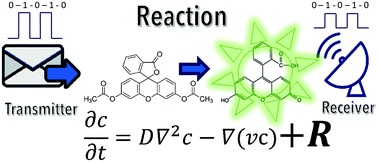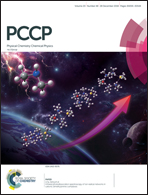Reactive messengers for digital molecular communication with variable transmitter–receiver distance
Abstract
Molecular communication exploits functional molecular systems travelling along fluid media to deliver messages encoded as concentration pulses, e.g. molecular bits. As the bits are naturally broadened by diffusion, limiting the distance along which information can be transferred, by careful design and optimization of the molecular messengers, is required. A new paradigm, exploiting the chemical reactivity of a suitable molecular messenger, has been developed to achieve long range information transfer with variable transmitter–receiver distances. The experimental results and theoretical simulations, carried out by using fluorescent molecules switched by pH-driven hydrolysis, are reported here. In particular, we simulated the information transport process by using numerical solutions of differential equations governing information swapping and we show that by exploiting the reactivity of the chemical messenger, a stable signal at the receiver is maintained within a wide range of distance. This theoretical prediction was fully experimentally verified by using a prototypal molecular communication platform.



 Please wait while we load your content...
Please wait while we load your content...